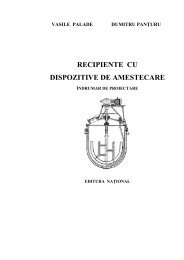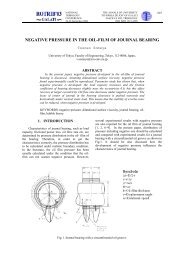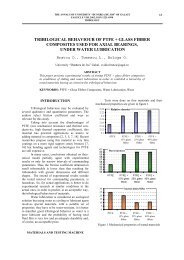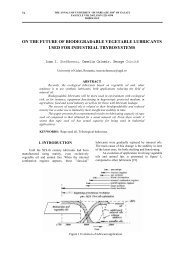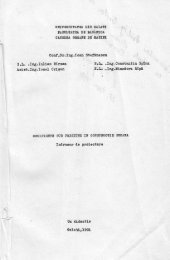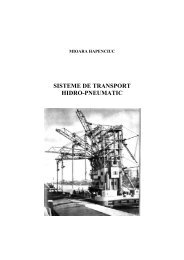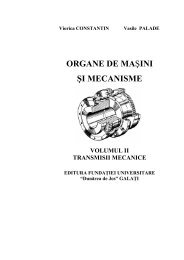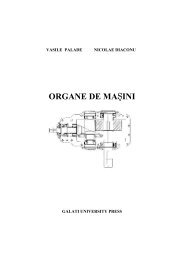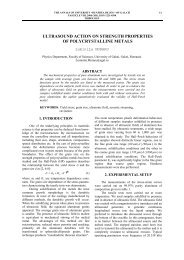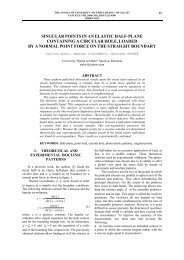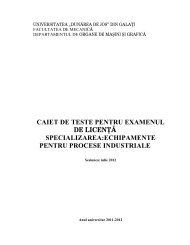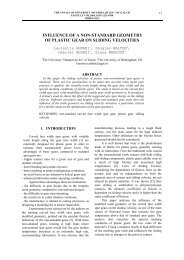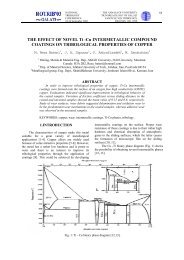flammability test data in risk assessment
flammability test data in risk assessment
flammability test data in risk assessment
You also want an ePaper? Increase the reach of your titles
YUMPU automatically turns print PDFs into web optimized ePapers that Google loves.
THE ANNALS OF UNIVERSITY “DUNĂREA DE JOS“ OF GALAŢI<br />
FASCICLE VIII, 2008 (XIV), ISSN 1221-4590<br />
TRIBOLOGY<br />
73<br />
characteristic that is not mentioned <strong>in</strong> ISO standard,<br />
but was recorded dur<strong>in</strong>g these prelim<strong>in</strong>ary <strong>test</strong>s, was<br />
the time <strong>in</strong>terval till the fluid starts to burn, time<br />
measured from the start<strong>in</strong>g of the fluid dispens<strong>in</strong>g<br />
process. From Table 3, one may notice that the grade<br />
oil ACEA-2002 A2/B2 – API SL/CF had the largest<br />
time <strong>in</strong>terval between drop start<strong>in</strong>g and burn start<strong>in</strong>g<br />
on the hot manifold. This larger time may be crucial<br />
<strong>in</strong> activat<strong>in</strong>g the fire suppression systems. Another<br />
important aspect noticed dur<strong>in</strong>g these <strong>test</strong>s was the<br />
quality and quantity of the residues left on the<br />
manifold, <strong>in</strong> the tray and on the metal box walls.<br />
Vary<strong>in</strong>g the manifold temperature and repeat<strong>in</strong>g<br />
the <strong>test</strong> methodology it is possible to establish a temperature<br />
(or a very narrow range of temperature) to<br />
ignite the fluid, under the <strong>test</strong> conditions. This temperature<br />
could be compared to the ignition po<strong>in</strong>t or flash<br />
po<strong>in</strong>t, this comparison be<strong>in</strong>g a criterion for establish<strong>in</strong>g<br />
the degree of hazardous probability for the fluid.<br />
Fig. 2. Tester for determ<strong>in</strong><strong>in</strong>g the <strong>flammability</strong> characteristics of fluids <strong>in</strong> contacts with hot surfaces.<br />
Table 3 Prelim<strong>in</strong>ary results <strong>in</strong> determ<strong>in</strong><strong>in</strong>g the <strong>flammability</strong> characteristics of fluids <strong>in</strong> contacts with hot<br />
surfaces (methodology as required by EN ISO 20823:2003) Average high 300± 10 mm, Oil volume 10±0.5 ml.<br />
Number<br />
Tested<br />
oil of<br />
<strong>test</strong><br />
Comments<br />
Oil<br />
grade<br />
H.G. 46<br />
Manifold<br />
temperature<br />
( o C)<br />
Dropp<strong>in</strong>g<br />
time<br />
(sec)<br />
1 620 45<br />
2 620 45<br />
3 620 45<br />
1 700 50-60<br />
Oil<br />
grade<br />
T 90<br />
API<br />
2 700 50-60<br />
GL-2 3 700 o C 50-60<br />
Oil grade<br />
ACEA-<br />
2002<br />
A2/B2 –<br />
API<br />
SL/CF<br />
1 700 o C 50-60<br />
2 700 50-60<br />
3 700 50-60<br />
Permissible<br />
deviation<br />
of<br />
parameters<br />
±20 o C;<br />
± 10 sec;<br />
±20 o C;<br />
± 10 sec;<br />
±20 o C;<br />
±0.5 ml;<br />
± 10 sec;<br />
- the fluid ignites after 5-7 sec and after dropp<strong>in</strong>g 1…1,5 ml of<br />
fluid;<br />
- <strong>test</strong> result: I(T), when the fluid flashes or burns on the tube<br />
but does not cont<strong>in</strong>ue to burn when collected <strong>in</strong> the tray below.<br />
- the fluid ignites on the manifold after 5…10 sec of start dropp<strong>in</strong>g<br />
and it burns <strong>in</strong> the tray below.<br />
- <strong>test</strong> result: I(D), when the fluid flashes or burns on the tube<br />
and cont<strong>in</strong>ues to do so when collected <strong>in</strong> the tray below<br />
- the fluid ignites and burns after 22 sec from drop start<strong>in</strong>g; it burns<br />
on the manifold, dur<strong>in</strong>g its dripp<strong>in</strong>g but it does not burn <strong>in</strong> the tray,<br />
- a lot of residue was noticed after burn<strong>in</strong>g on the tube but also on<br />
the walls of the high-temperature metal enclosure,<br />
- <strong>test</strong> result: I(D), when the fluid flashes or burns on the tube<br />
and cont<strong>in</strong>ues to do so when collected <strong>in</strong> thetray below



